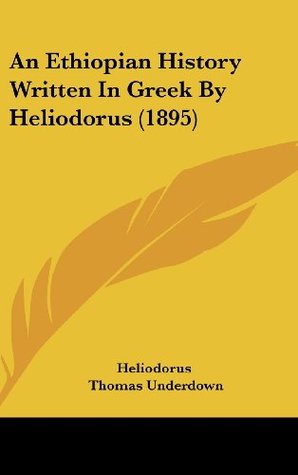

 |

|

The average rating for History of Scottish Rite Masonry in Chicago: From Its Introduction until the Semi-Centennial... based on 2 reviews is 4.5 stars.
Review # 1 was written on 2010-11-30 00:00:00 Philip Dolaway Philip Dolaway(998 From 1001 Books) - Αἰθιοπικά = Aithiopika = Aethiopica = Aethiopica, Heliodorus = Heliodorus of Emesa Chariclea, the daughter of King Hydaspes and Queen Persinna of Ethiopia, was born white through the effect of the sight of a marble statue upon the queen during pregnancy (an instance of the theory of maternal impression). Fearing accusations of adultery, Persinna gives her baby daughter to the care of Sisimithras, a gymnosophist, who takes the baby to Egypt and places her in the care of Charicles, a Pythian priest. Chariclea is then taken to Delphi, and made a priestess of Artemis. The novel is thought to have originally been written in the 2nd or 3rd century A.D. Nothing is known about the author, Heliodorus. تاریخ نخستین خوانش: روز بیست و ششم ماه ژانویه سال 2002 میلادی نخستین آثار داستانی بلند و عاشقانه را، باید در سده های دوم و سوم میلادی جست، که نویسنده ای «یونانی» آن را به نثر نوشتند؛ این اثر از دو شخصیتِ تنها، به عنوان عاشق و معشوق، سخن میگوید، که پس از آزمون و رنج بسیار، و از سر گذراندن رویدادهای پرهیجان، در پایان داستان به وصال هم میرسیند؛ شاخصترترین روایت ادبیِ عاشقانه ی «یونانی»، که ادبیات اروپاییِ پس از خود را، تحت تأثیر قرار داده، همین «اتیوپیکا» نوشته ی «هلیودوروس حمصی» است دختر پادشاه هیداسپس، و ملکه پرشینا از اتیوپی، در اثر مشاهده ی یک مجسمه سنگ مرمر، بر روی ملکه، در دوران بارداری، سفید متولد شد (نمونه ای از تئوری تأثیر مادر)؛ پرشینا از ترس اتهام زنا، دختر بچه اش را زیر دیدگاه سیزیمیترا، قرار میدهد تا کودک را به مصر ببرد و او را زیر نظر کشیش پیتیایی قرار دهد؛ دختر سپس به دلفی میرود، و یک کاهن آرتمیس میشود بالای صخره ای دوشیزه ای با چنان زیبایی ناباورانه نشسته بود که گویا باید الهی باشد ...؛ سر او بدون حرکت به سمت جلو متمایل شد، زیرا او به طور دقیق به جوانی نگاه میکرد، که زیر پاهای او دراز کشید؛ این مرد با زخمها بدشکل شده بود، اما به نظر میرسید که از خواب عمیق، و تقریباً خود مرگ، خود را بیدار کند؛ از درد چشمانش را فشرده بود، اما دختر دوشیزه آنها را به سمت خود کشاند؛ او نفسش را جمع کرد، آه ژرفی کشید و با ضعف زمزمه کر؛ به شیرینی گفت: آیا تو واقعاً ایمن هستی، یا اینکه بیش از حد در جنگ آسب دیده ای؟ تاریخ بهنگام رسانی 16/12/1399هجری خورشیدی؛ ا. شربیانی |
Review # 2 was written on 2014-02-24 00:00:00 Maxwell Edwards Maxwell EdwardsHow old is the novel? Can you identify the first novel? I've heard lots of people say Don Quixote is the first. It was written in the early seventeenth century. The most commonly cited first novel is The Tale of Genji, dated to the late tenth, early eleventh century. If you google the words "oldest novel", Genji is the top result. I don't understand how this and other ancient Greek novels were overlooked, though. Heliodorus's work, alternatively known as Aithiopika, An Ethiopian Story, etc. is a 250+ page novel about two lovers cast about the Egyptian, Persian and Ethiopian countrysides, continuously falling in and out of captivity, always in danger of being sacrificed to a heathen god or killed in battle or sold into slavery. It is a novel by any common definition. And it predates Genji by about 700 years. The truly oldest novel known to the modern world, Chariton's Callirhoe, was written in the first century of the common era, almost a thousand years before Genji. I'm sure Genji is a fine piece of writing, but COME ON, PEOPLE! As for the book itself... it's an incredibly fun adventure story, filled with swashbuckling and horse riding and wrestling matches. It's basically the authentic The Princess Bride. Another thing that makes it really interesting and fun is that it's a book of stories within stories within stories. Often, a character will start a story only to meet a character within his story who would like to tell a story of his own, within which, of course, lies another story. This is known as subsequent layers (a fact taught to me by the all-knowing Wikipedia.) It can get confusing, but it's all riveting stuff. And all the stories are relevant to the main plot, unlike many of the digressive stories of Don Quixote or the essays within Les Misérables. And I must mention that William Shakespeare was apparently a fan. He references Aithiopika in Twelfth Night when he writes: Why should I not, had I the heart to do it, Like to the Egyptian thief at point of death, Kill what I love? Aithiopika feels very Shakespearean, in fact. It has the gravity of Shakespeare's tragedies without itself being a tragedy. Its intricate and complex plot recalls those of the bard. Obviously, highly recommended. It's not easy to find, however. I figured it would be readily available on the interwebs in ebook format, but all I could find were badly scanned PDFs. I would recommend getting Collected Ancient Greek Novels, which will give you several ancient gems, including the aforementioned oldest extant novel. |
CAN'T FIND WHAT YOU'RE LOOKING FOR? CLICK HERE!!!